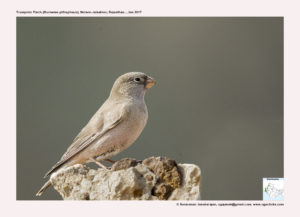Trumpeter Finch

Trumpeter Finch Bucanetes githagineus
Etymology:
- Bucanetes : Greek Word for bukanetes – Trumpeter
- Githagineus : Latin word gith – coriander; ago –resembling
Distribution in India: Winter visitor in North West India.
Description: Size of 12·5–15 cm; wt. of 16–25 g. It is a medium-sized to large, stocky, large-headed finch with large, blunt bill and short tail. The male of nominate race in breeding has bright red to reddish-pink on forehead to cheek, chin and throat, lores are washed ash-grey, upper forehead to nape, side of neck and face pale are ashy grey, tinged slightly browner or pinkish on face and streaked finely darker on crown. It has a narrow white eyering; upperparts, lesser and median upperwing-coverts are sandy brown with slightly darker feather centres. The rump and uppertail-coverts are pink; tail is dark brown or grey-brown, broadly edged pink. The median upperwing-coverts are fringed pale pink, greater coverts are drab brown with pink fringes, broadly fringed pink, rest of wing is dark brown. It is finely edged pale pink on primary coverts and secondaries and deeper pink on primaries and finely tipped whitish-buff, tertials are browner and fringed pinkish-buff. The side of throat and breast are pinkish-buff, tipped or spotted brighter pink, lower breast and belly are pinkish-buff with paler or greyer feather bases, flanks are paler brown, tinged pink, undertail-coverts are whitish, washed pale pink. The iris is dark brown or black. The bill is bright orange-red; legs are flesh-brown. The non-breeding male in fresh plumage lacks pink on forehead and face and is paler or duller grey-brown or sandy brown on head, mantle, back, underparts and edges of wing-coverts and flight-feathers. The edges of greater coverts and primary coverts and flight-feathers are narrowly tinged pinkish, tips of secondaries and primaries more broadly pale buff; bill is yellow. The female is like non-breeding male, but paler or duller sand-brown, rump, uppertail-coverts, tips of wing-coverts and edges of flight-feathers are variably pale buff or pinkish-buff to pinkish-orange. It has tinge of pink on lores, lower ear-coverts, chin, throat and breast, rest of underparts are sandy buff, lightly streaked more heavily buffish; bill is pale yellow to yellowish-horn with pinkish or orange tinge, during breeding lower mandible usually is yellow or orange-yellow. The juvenile is browner or more sandy than female, lacking pink, all upperwing-coverts and edges of flight feathers fringed pale brown or buff-brown, bill dull brown or greyish-horn.
Habitat: It is found in desert, semi-desert and desert edges, vast open steppe areas, including dry desolate hills with sparse low scrub, edges of cultivation, mountain slopes, treeless stony plains, cliffs, ravines, gorges and wadis. It is found below 1900 m.
Food habits: It eats small seeds, shoots and buds of grasses and low ground-loving plants, cereals, berries, buds, insects and larvae. The nestling diet is seeds, either green or as regurgitated pulp. It forages on ground, where it creeps, runs, hops and shuffles often rapidly; becomes upright when alarmed. It extracts seeds from bent-over grass heads, also digs into soft sandy soil and pecks grains from animal dung. It is found in pairs and in small to large flocks. It frequently flies a good distance to drink, especially in late afternoon or evening.
Breeding habits: They breed in Feb–Jun in Canary Island, Caucasus, Israel, Morocco and Central Asia. They are monogamous. They are solitary or loosely colonial. The pair formation starts from break-up of flocks at start of breeding season. The male performs song flight, rising rapidly with vigorous wing beats in wide circles, changing direction erratically, and descending in long glide. The courtship includes bill-touching by the two partners, and displaying male may stand upright with plumage sleeked, crest feathers raised, wings lowered exposing pink rump and tail partly spread, belly and flanks feathers also ruffled, while hopping from side to side, calling loudly, in front of female. The nest is built by female. The nest is mostly a loose collection of twigs, plant stalks, down and fibres, grass, animal hair and occasionally feathers, placed in shallow depression in ground, under rock, shrub or grass tussock, above ground in pipe or wall of house. The nests in cavity between rocks may have small stones placed at entrance. They lay a clutch of 4–6 eggs. The incubation is done by female. The incubation period is 11–14 days. The chicks are fed and cared for by both parents. The nestling period is 12–14 days. The young frequently leave nest before able to fly. The young are independent 11 days after fledging.